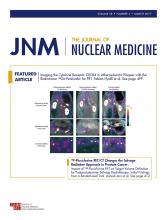TO THE EDITOR: The recent article by Jeffry A. Siegel, Charles W. Pennington, and Bill Sacks (1) credibly demonstrates the fallacy of the linear no-threshold hypothesis (LNTH) and its illegitimate ALARA (as low as reasonably achievable) progeny as applied to medical imaging. The authors note that credible evidence of imaging-related carcinogenic risk at low absorbed dose (<100 mGy) is nonexistent. Any perceived risk is a hypothetical consequence of the presumed validity of the scientifically unjustified LNTH, and low-dose radiation does not cause, but more likely helps prevent, cancer. Siegel et al. (1) observe that the LNTH and associated ALARA concepts are fatally flawed and focus only on molecular damage while ignoring protective, organismal biologic responses. The article clearly illustrates the societal harm caused by the LNTH and ALARA.
The LNTH also affects acceptance of the use of radiation and radioactive materials and causes the ALARA concept to create harm rather than the presumed benefit. These concepts create a world in which ALARA becomes “A Law Against Radiation Applications.” The negative societal impact of the LNTH and ALARA concept is significant (1–5).
Negative ramifications of the LNTH and associated ALARA concept include a limitation of research using radiation and radioactive materials, adverse impact on medical diagnoses, limitation of nuclear energy expansion in the United States and Europe, deterrence of the achievement of lower costs for radiation-related services, slowed recovery from the Fukushima Daiichi accident, and contribution to the unwarranted public fear of radiation and radioactive materials.
Radiophobia has inhibited research using low-dose radiation in the detection, prevention, and treatment of cancer and other diseases. Unwarranted fears caused by belief in the LNTH have also effectively inhibited research involving unique applications of radiation and radioactive materials. These applications include the use of low-dose radiation as a treatment protocol.
Patients have refused to undergo CT scans, and physicians are not prescribing these procedures because the LNTH has created concern about the subsequent radiation detriment. This fear could result in missed diagnoses because imaging doses are too low to produce adequate tissue resolution (5).
The expansion of nuclear energy in the United States and Europe has been limited because the radioactive releases resulting from Three Mile Island, Chernobyl, and Fukushima Daiichi reinforced unjustified fears regarding the effects of radiation (4,6). These effects include incorrect assumptions regarding the connection between cancer and hereditary effects and low doses of ionizing radiation. The associated radiophobia promotes the use of higher-cost and polluting energy-generating sources that negatively affect economic growth.
Increased regulation of radiation and radioactive materials and the associated costs to implement compliance further dampen the expansion and use of radiation and radioactive materials. Regulations affect consumer, medical, industrial, health care, and research applications and result in significantly increased costs with limited benefit.
These concerns are illustrated by a simple example of resource allocation. Nuclear facilities (e.g., power reactors and fuel cycle facilities) devote significantly more personnel and attention to radiation safety driven by LNTH/ALARA than to industrial safety. The imagined benefit of saving 10 μSv (1 mrem) leads to a larger resource allocation for radiation safety. Commonplace signs and slogans promoting the fact that “Every Millirem Counts” further reinforce LNTH/ALARA and its misguided basis. The resources devoted to saving trivial doses come at the expense of worker health and safety and prioritize radiation safety based on the LNTH/ALARA myth over industrial safety. These issues go beyond trip-and-fall hazards. The imagined radiation risk is deemed to be more important than actual risks. For example, steam and chemical burns and heavy load drops are real events that have occurred and caused serious injuries. These are real issues rather than the imagined benefits derived from LNTH/ALARA.
Jeffry A. Siegel, Charles W. Pennington, and Bill Sacks should be applauded for illustrating the LNTH fallacy. Hopefully, their work will cause professionals to challenge poor science and use radiation and radioactive materials to their full potential.
Footnotes
Published online Jan. 26, 2017.
- © 2017 by the Society of Nuclear Medicine and Molecular Imaging.







